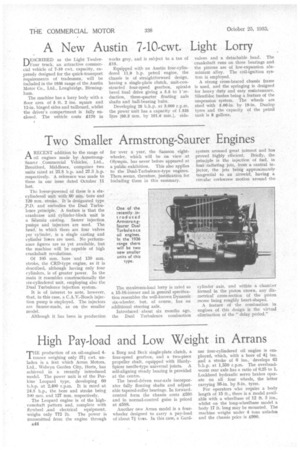Two Smaller Armstrong-Saurer. Engines
Page 86

If you've noticed an error in this article please click here to report it so we can fix it.
ARECENT addition to the range of oil engines made by. ArmstrongSaurcr ..Commercial Vehicles, Ltd., Breritford, Middlesex, comprises two units rated at 23.8 h.p. and 27.3 .h.p. respectively. A reference was made to these in our issue dated October 11 last.
The lower-powered of these is a sixcylindered unit with 60 Min: bore and 120 mm. stroke. It is designated type P.D. and embodies the Dual Turbulence principle. A feature is that the crankcase and cylinder-block unit is a Silumin casting. Saurer injection pumps and injectors are used. The head, in which there are four valves per cylinder, is a single casting and cylinder liners are used. No performance figures are as yet available, but the machine will be capable of high crankshaft revolutions.
Of 105 mm. bore and 130 mm. stroke, the CRD-type engine, as it is described, although having only four cylinders, is of greater power. In the main it resembles constructionally the six-cylindered unit, employing also the Dual Turbulence injection system.
It is of interest to note, however, that, in this case, a C.A.V.-Bosch injection pump is employed. The injectors are Saurer-made, as on the smaller model.
Although it has been in production
for over a year, the Samson eight. wheeler, which will be on view at Olympia, has never before appeared at• a public exhibition. This also applies to the Dual-Turbulence-type engines. There seems, therefore, justification for including them in this summary.
The maximum-load lorry is rated as a 15-16-tormer and in general specification resembles the well-known Dynamic six-wheeler, but, of course, has an additional steering axle.
Introduced about six months ago, the Dual Turbulence combustion system aroused great interest and has proved highly efficient. Briefly, the principle is the injection of fuel, in four radiating jets, from a central injector, the jets being approximately tangential to an airswirl, having a circular corkscrew motion around the cylinder axis, and within a chamher formed in the piston crown, any diametrical cross-section of the piston recess being roughly heart-shaped.
.A feature of the combustion in engines of this design is the virtual elimination of the "delay period."
















































































































































